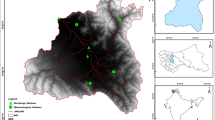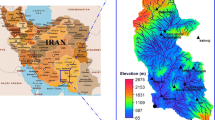Abstract
Water resource and hydrologic modeling studies are intrinsically related to spatial processes of hydrologic cycle. Due to generally sparse data, and high rainfall variability, the accurate prediction of water availability in complex semi-arid catchment depends to a great extent on how well spatial input data describe realistically the relevant characteristics. The Geographic Information System (GIS) provides the framework within which spatially distributed data are collected and used to prepare model input files. Despite significant recent developments in distributed hydrologic modeling, the over-parameterization is usually a critical issue that can complicate calibration process. Sensitivity analysis methods reducing the number of parameters to be adjusted during calibration are important for simplifying the use of these models. The objective of this paper is to perform a sensitivity analysis for flow in a semi-arid catchment (1,491 km2), located in northwestern of Tunisia, using the Soil and Water Assessment Tool (SWAT) model. The simulation results revealed that among eight selected parameters, curve number (CN2), soil evaporation compensation factor (ESCO), soil available water capacity (SOL_AWC) and threshold depth of water in the shallow aquifer required for return flow (GWQMN) were found to be the most sensitive parameters. Calibration of hydrology, facilitated by the sensitivity analysis, was performed for the period 2001 through 2003. Results of calibration showed that the model accurately predict runoff and performed well with a monthly Nash Sutcliffe efficiency (NSE) of 0,78, a coefficient of determination (R2) of 0,85 and a percent of bias (PBIAS) equal to −13,22 %.














Similar content being viewed by others
References
Abbaspour KC, Yang J, Maximov I, Siber R, Bogner K, Mieleitner J, Zobrist J, Srinivasan R (2007) Modelling hydrology and water quality in the prealpine/alpine Thur watershed using SWAT. J Hydrol 333:413–430
Aouissi J, Benabdallah S, Chabaane ZL, Cudennec C (2014) Modelling water quality to improve agricultural practices and land management in a Tunisian catchment using the soil and water assessment tool. J Environ Qual 43:18–25
Arabi M, Govindaraju RS, Hantush MM, Engel BA (2006) Role of watershed subdivision on modeling the effectiveness of best management practices with SWAT. J Am Water Resour Assoc 42(2):513–528
Arnold JG, Williams JR, Maidment DR (1995) Continuous-time water and sediment routing model for large basins. J Hydraul Eng 121(2):171–183
Arnold JG, Srinivasan R, Muttiah RS, Williams JR (1998) Large area hydrologic modeling and assessment. Part I: Model Dev J Am Water Resour Assoc 34:73–89
Arnold JG, Moriasi DN, Gassman PW, Abbaspour KC, White MJ, Srinivasan R, Santhi C, Harmel RD, van Griensven A, Van Liew MW, Kannan N, Jha MK (2012) SWAT: model use, calibration and validation. T ASABE 55(4):1491–1508
Bicknell BR, Imhoff JC, Donigian AS, Johanson RC (1997) Hydrological simulation program - FORTRAN (HSPF): User’s manual for release 11. EPA/600/R-97/080. U.S. EPA, National Exposure Research Laboratory, Athens, GA, 755p.
Bilondi MP, Abbaspour KC, Ghahraman B (2013) Application of three different calibration uncertainty analysis methods in a semi-distributed rainfall-runoff model application. Middle East J Sci Res 15(9):1255–1263
Bouraoui F, Benabdallah S, Jrad A, Bidoglio G (2005) Application of the SWAT model on the Medjerda river basin (Tunisia). Phys Chem Earth 30:497–507
Chahinian N, Tournoud MG, Perrin JL, Picot B (2011) Flow and nutrient transport in intermittent rivers: a modeling case-study on the V’ene river using SWAT 2005. Hydrol Sci J 56:268–287
Chaplot V (2005) Impact of DEM mesh size and soil map scale on SWAT runoff, sediment and NO3-N loads predictions. J Hydrol 312:207–222
Chaplot V, Saleh A, Jaynes DB (2005) Effect of the accuracy of spatial rainfall information on the modeling of water, sediment, and NO3–N loads at the watershed level. J Hydrol 312:223–234
Chaubey I, Cotter AS, Costello TA, Soerens TS (2005) Effect of data resolution on SWAT output uncertainty. Hydrol Process 19(3):621–628
Cho J, Bosch D, Lowrance R, Strickland T, Vellidis G (2009) Effect of spatial distribution of rainfall on temporal and spatial uncertainty of SWAT output. T Am Soc Agr Biol Eng 52(5):1545–1555
Cibin R, Sudheer KP, Chaubey I (2010) Sensitivity and identifiability of streamflow generation parameters of the SWAT model. Hydrol Process 24:1133–1148
Fadil A, Rhinane H, Kaoukaya A, Kharchaf Y, Bachir OA (2011) Hydrologic modeling of the bouregreg watershed (morocco) using GIS and SWAT model. J Geogr Inf Syst 3:279–289
Fiseha BM, Setegn SG, Melesse AM, Volpi E, Fiori A (2013) Hydrological analysis of the upper Tiber river basin, central Italy: a watershed modelling approach. Hydrol Process 27:2339–2351
Francos A, Elorza FJ, Bouraoui F, Bidoglio G, Galbiati L (2003) Sensitivity analysis of distributed environmental simulation models: understanding the model behavior in hydrological studies at the catchment scale. Real Eng Syst Safe 79(2):205–218
Gao Y, Zhang H, Xu G (2012) Analysis on effect of spatial distribution of rainfall on runoff modeling in xixi watershed of jinjiang basin. Appl Mech Mater 212–213:151–154
Gassman PW, Reyes MR, Green CH, Arnold JG (2007) The soil and water assessment tool: historical development, applications, and future research directions. T ASABE 50(4):1211–1250
Gong Y, Shen Z, Liu R, Wang X, Chen T (2010) Effect of watershed subdivision on SWAT modeling with consideration of parameter uncertainty. J Hydrol Eng 15(12):1070–1074
Gupta HV, Sorooshian S, Yapo PO (1999) Status of automatic calibration for hydrologic models: comparison with multilevel expert calibration. J Hydrologic Eng 4(2):135–143
Hargreaves GH, Samani ZA (1985) Reference crop Evapotranspiration from temperature. Appl Eng Agric 1:96–99
Hawkins RH, Ward TJ, Woodward DE, Van Mullem JA (2009) Curve number hydrology: state of the practice. ASCE, Reston
Holvoet K, van Griensven A, Seuntjens P, Vanrolleghem PA (2005) Sensitivity analysis for hydrology and pesticide supply towards the river in SWAT. Phys Chem Earth 30:518–526
Jha M, Gassman WP, Secchi S, Gu R, Arnold J (2004) Effect of watershed subdivision on SWAT flow, sediment and nutrient predictions. J Am Water Resour As 40(3):811–825
Krause P (2002) Quantifying the impact of land use changes on the water balance of large catchments using the J2000 model. Phys Chem Earth 27:663–673
Krysanova V, Wechsung F, Arnold J, Srinivasan R, Williams J (2000) PIK Report Nr. 69 “SWIM (Soil and Water Integrated Model), User Manual”, 239 p.
Laflen JM, Lane LJ, Foster JR (1991) WEPP: a new generation of erosion prediction technology. J Soil Water Conserv 46(1):34–38
Lin S, Jing C, Chaplot V et al (2010) Effect of DEM resolution on SWAT outputs of runoff, sediment and nutrients. Hydrol Earth Syst Sci Discuss 7:4411–4435
Liu YB (2004) Development and application of a GIS-based hydrological model for flood prediction and watershed management. PhD Thesis, Vrije Universiteit Brussel, Belgium.
Morgan RPC (2001) A simple approach to soil loss prediction: a revised morga-Morgan finney model. Catena 44(4):305–322
Moriasi DN, Arnold J, Van Liew MW, Binger RL, Harmel RD, Veith T (2007) Model evaluation guidelines for systematic quantification of accuracy in watershed simulations. Trans Am Soc Agric Biol Eng 50(3):885–900
Mosbahi M, Benabdallah S, Boussema MR (2009) Influence des données d’entrée du modèle SWAT sur la quantification des pertes en sol dans un bassin versant semi-aride en Tunisie. Le J De L’eau L’Environ 13–14:84–91
Neitsch SL, Arnold JG, Kiniry JR, Williams JR, King KW (2002) Soil water assessment tool theoretical document, version 2000, Grassland, Soil and Water Research Laboratory, Temple, Texas, 506 p
Neitsch SL, Arnold JG, Kiniry JR, Williams JR (2005) Soil and Water Assessment Tool, theoretical documentation version 2005. Grassland, Soil and Water Research Laboratory, Texas
Ouessar MP, Bruggeman A, Abdelli F, Mohtar R (2006) Use of SWAT model for the assessment of land use changes in an arid watershed of Southeast Tunisia. 14th International Soil Conservation Organization Conference. Water Management and Soil Conservation in Semi-Arid Environments. Marrakech, Morocco, May 14–19, 2006
Pilgrim DH, Chapman TG, Doran DG (1988) Problems of rainfall-runoff modeling in arid and semi-arid regions. Hydrol Sci J 33(4):379–400
Saltelli A, Chan K, Scott EM (2000) Sensitivity analysis. Wiley, New York
Santhi C, Srinivasan R, Arnold JG, Williams JR (2006) A modeling approach to evaluate the impacts of water quality management plans implemented in a watershed in Texas. Environ Model Softw 21:1141–1157
Schuol J, Abbaspour KC (2007) Using monthly weather statistics to generate daily data in a SWAT model application to west africa. Ecol Model 201:301–311
Sellami H, La Jeunesse I, Benabdallah S, Baghdadi N, Vanclooster M (2013) Uncertainty analysis in model parameters regionalization: a case study involving the SWAT model in Mediterranean catchments (southern France). Hydrol Earth Syst Sci Discuss 10:4951–5011
Singh VP, Woolhiser DA (2002) Mathematical modeling of watershed hydrology. J Hydrol Eng 7:270–292
Spruill CA, Workman SR, Taraba JL (2000) Simulation of daily and monthly stream discharge from small watersheds using the SWAT model. T ASAE 43(6):1431–1439
USDA-SCS (1972) National Engineering Handbook. Hydrology Section 4, Chapter 4-10. US Department of Agriculture, Soil Conservation Service, Washington, DC
Van Griensven A, Francos A, Bauwens W (2002) Sensitivity analysis and auto-calibration of an integral dynamic model for river water quality. Water Sci Technol 45(5):321–328
Van Griensven A, Meixner T, Grunwald S, Bishop T, Diluzio M, Srinivasan R (2006) A global sensitivity analysis tool for the parameters of multi-variable catchment models. J Hydrol 324:10–23
Westervelt JD (2002) Geographic information systems and agent-based modelling. In: Gimblett HR (ed) Integrating geographic information systems and agent-based modeling techniques for simulating social and ecological processes. Oxford University Press, Oxford, pp 83–103
White KL, Chaubey I (2005) Sensitivity analysis, calibration, and validations for a multisite and multivariable SWAT model. J Am Water Resour As 41(5):1077–1089
Williams JR, Berndt HD (1977) Sediment yield prediction based on watershed hydrology. Trans Am Soc Agric Eng 20:1100–1104
Young RA, Onstad CA, Bosch DD (1989) AGNPS: a nonpoint-source pollution model for evaluating agricultural watersheds. J Soil Water Conserv 44:168–173
Acknowledgments
The authors wish to express their gratitude to the Soil and Water Land Agriculture Authority for supplying land use database.
Author information
Authors and Affiliations
Corresponding author
Additional information
Communicated by: H. A. Babaie
Rights and permissions
About this article
Cite this article
Mosbahi, M., Benabdallah, S. & Boussema, M.R. Sensitivity analysis of a GIS-based model: A case study of a large semi-arid catchment. Earth Sci Inform 8, 569–581 (2015). https://doi.org/10.1007/s12145-014-0176-0
Received:
Revised:
Accepted:
Published:
Issue Date:
DOI: https://doi.org/10.1007/s12145-014-0176-0




